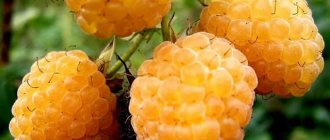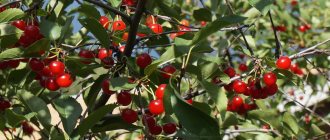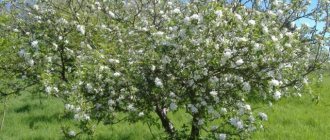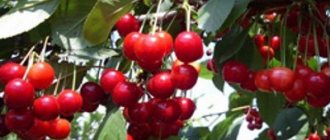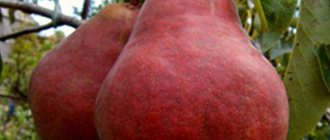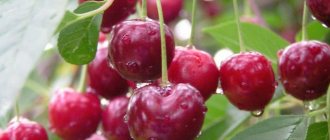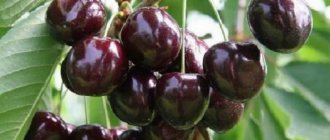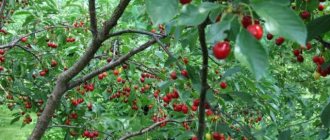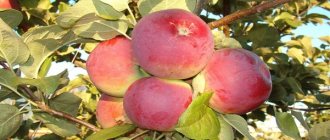Description of plum "Yellow Khopty"
The specified fruit crop has the following specific external and structural characteristics:
Tree .
It is a vigorous plant (less commonly, moderate in growth). Its height is usually 2.5 m or more. At the same time, the tree trunk itself is relatively not very high.The bark on the plum trunk is smooth to the touch, mostly gray in color.
- Crown, branches .
In an adult, a mostly sparse (sometimes medium-density) apex is formed in the form of a slightly flat circle. The crown is formed by largely spreading branches. The smooth bark of the skeletal branches is gray in color. - Escapes .
Straightened (sometimes somewhat curved) shoots have a fairly thick cross-section. The color of the shoots is light brown, with some gloss on the surface. A large number of small lentils are formed on the shoots. Vegetative type buds are very small in size, while fruit buds are medium in size. - Leaves .
Sizes - from medium to large. The length of a regular leaf is 11 cm, width - 6 cm. The maximum expansion is observed closer to the top. The leaves grow ovoid. The main color is green, with a slight shine. There are barely noticeable wrinkles on the surface of the sheet. - Inflorescences .
Medium-sized white flowers bloom in the form of cups. The egg-shaped petals are 9 mm long and 7 mm wide. There is a slight waviness on the edges of the petals. Usually 2-3 flowers are collected in one bud. - Fruit. Yellow or light yellow fruits with a whitish waxy coating are characterized by medium size, weighing between 16-20 g.
The shape is generally round, with slight flattening. A seam is clearly visible on the abdomen of the fetus. Under the thin skin the pulp is yellow-green, quite loose, rich in juice.Inside there is a relatively large bone that is easily separated from the pulp.
Advantages and disadvantages of yellow plum
The varieties listed above have an important advantage - high yield. But many have other advantages and disadvantages. Thus, the Altai jubilee yellow plum was bred from Chinese varieties. Like many Far Eastern species, it is not suitable for the climatic conditions of Central Russia. But the variety has its advantages. In addition to very tasty fruits, it is also resistant to diseases, in particular to hole spot.
The Amber plum described above has the same advantage. It is very resistant to classic stone fruit diseases, but has another drawback. If plums are fully ripe, they will not be stored for long due to the skin on the fruit being too thin. Therefore, it is recommended to harvest the crop in a slightly unripe state.
Important! Such fruits can be kept in the refrigerator for a long time, where they gradually reach the desired condition.
The Honey Yellow Plum is close in many characteristics to the variety described above. However, the fruits have a higher shelf life, so they can be easily transported. The only drawback of the variety is its tallness. This means that such a tree requires more attention. In the spring, pruning must be done, otherwise in a few years there will be no fruit on the low-growing branches.
History of selection
The plum variety “Yellow Khopty” was bred in 1930 by Russian breeder N. Tikhonov. The research was carried out in the city of Ussuriysk, in the garden of the amateur gardener Khopta.
Tikhonov did a lot for the practical cultivation of new fruit in the Asian half of Russia. In subsequent years, this plum became one of the main varieties in horticultural farms in Siberia, the Urals and the Far East.
Already in 1974, “Yellow Khopty” was included in the state varietal register and officially zoned for the West Siberian and Ural regions.
From the very beginning of its existence, this plum variety began to be actively used by many breeding scientists to create new high-quality varieties.
In particular, for the Altai region, with the participation of “Yellow Khopta”, “Zarya Altai” and several other promising species were bred, and in Krasnoyarsk – the “Divnaya” plum.
From “Yellow Khopta” to new varieties, its good adaptability to local climatic conditions and good yield are passed on. At the same time, its offspring can receive from the “parent” a clearly defined bitterness of its skin.
Diseases and pests
The voracious larvae of this hymenoptera almost completely eat the grains. As a result, the plums dry out, turn black and fall off.
To effectively combat this pest, summer spraying (in mid-June) with a 0.2% solution of lepidocide or chlorophos is used. It is better to collect already affected fruits from the tree in advance.
The tasty and aromatic fruits of this Chinese plum can be a real decoration for a feast and an excellent option for its dessert part. However, all this will become possible only after applying knowledge, experience and constant work to this plant.
If you find an error, please select a piece of text and press Ctrl+Enter.
Characteristics of the variety
This plum is a self-sterile fruit crop. Such plants, as a rule, have virtually no ability to self-fertilize due to pollination with their own pollen.
For this reason, when planting a tree of the “Yellow Khopty” variety , the gardener needs to place nearby trees of other plum varieties, the flowering of which occurs at the same time as the described plum blossoms.
This variety is propagated by grafting. Currently, some varieties of Ussuri and Canadian selections are considered “Yellow Khopta”
Normal fruiting of this plum begins 3-4 years after planting an annual seedling. Subsequently, if all necessary agrotechnical conditions are met, the tree annually produces quite decent yields. In particular, on average, from one plant per season you can get up to 10-12 kg of fresh plums (or approximately 40-60 centners per hectare).
At the same time, the fruits, which usually ripen in August - early September, turn out to be very pleasant to the taste, in which sweetness with a slight attractive sourness predominates. At the same time, the weak point of the overall flavor bouquet is the skin, which gives off some bitterness.
Here you need to be especially careful, since this deficiency can also be transmitted to the processed products of “Yellow Khopta” .
The fruits contain the following chemical elements:
- sugar – 13.6%;
- titratable acids – 1.7%;
- dry matter – 21.8%;
- tannins – 0.74%;
- ascorbic acid – 12 mg/100 g;
- P-active substances – 150 mg/100 g.
It should also be noted that this variety has good winter hardiness . This applies to a greater extent to wood. But fruit buds may not withstand severe frosts, which must be taken into account when growing plums.
Ripe plum fruits are best eaten fresh. Due to the delicate skin and loose pulp, plums of this variety do not tolerate long-distance transportation.
Features of yellow plum varieties
There are many varieties of this crop and almost every year breeders develop new hybrids. They can be divided into several groups. So, there are self-fertile varieties. They produce crops on their own and do not require pollinators. However, despite all the advantages in terms of productivity, they are inferior to self-sterile varieties. On the latter, fruits are formed only if other plum crops grow nearby, which act as a pollinator. Therefore, it is important that trees grow on the site that will bloom at the same time as self-sterile crops.
Important! When choosing a suitable option, you should analyze parameters such as frost resistance, yield, fruit characteristics, etc.
For example, gardeners are often interested in a variety of small, round, golden-colored plums. It could be Altai Jubilee, Morning or Tatar Yellow. But of the listed options, only the first is universal, the rest have less frost resistance.
One of the best table varieties is the yellow plum Voskhod , bred on the basis of Renklod. These are fruits of greenish-yellow color with crimson splashes, covered with a bluish coating. Characteristics of this variety:
- high yield: on average, a six-year-old tree bears 49-50 kg of fruit. Moreover, it begins to bear fruit at the 4th year, sometimes at the 5th year. These fruits (and from a biological point of view, drupes) with a fairly dense skin and a small and easily separated stone appear in August. They are large, weighing up to 42-45 g;
- excellent taste: the pulp is juicy, sweet and sour;
- frost resistance.
The Khopta plum cannot boast of such large fruits. It bears small fruits weighing up to 20 g. But these plums have a pleasant sweet and sour taste. Their skin is thin and greenish-yellow in color. The stone is large and easily separated from the pulp. Yellow plum variety Khopta is a so-called self-sterile crop. This means that it must be fertilized at the expense of other plum trees. For these purposes, a variety with the same flowering period as Khopta is suitable. Among its positive characteristics are:
- excellent taste;
- the possibility of obtaining the first harvest within 3-4 years from the moment the tree is planted;
- good yield: up to 20 kg per tree;
- relatively high frost resistance, although the buds that appear in May do not tolerate frost well.
Mountain yellow plum is a mid-season variety. Ripens in the second half of August. The fruits are beautiful, large (24-25 g, but sometimes more), the pulp is sweet. The skin color of the fruit is light yellow. Among the characteristics of the Mountain yellow plum are the following:
- high winter hardiness, due to which it is suitable for cultivation in the Urals and Altai Territory;
- high yield (plum is also considered self-sterile, but in the presence of a pollinator it can produce up to 40 kg from one tree).
Note! The small Altai jubilee plum is considered an excellent pollinator in itself. It can be grown next to the varieties described above. Its fruits are small, rarely weighing more than 16 g, but their taste is very pleasant. The color is yellow, and on the sunny side it is reddish with a noticeable waxy coating. Productivity, although high, is irregular.
The Yantarnaya Mlievskaya plum has good performance . This variety was bred in Ukraine and is suitable for the southern regions because it is heat-loving. This is a self-fertile crop; it needs a good pollinator. But if it is there, then you can get a very high yield. It is considered a large-fruited variety, and these fruits are juicy, bright yellow, truly amber in color. The weight of one piece can be up to 70 g. Its features also include:
- very sweet taste with a subtle grape undertone. This type is considered by many to be the best for making jam, since ripe fruits contain a lot of pectin;
- good winter hardiness (it may not tolerate severe frosts, but moderate cold will not harm);
- early fruiting, since the first fruits on such a tree appear already 2 years after planting;
- high yield: 1 mature tree can produce up to 50 kg of plums.
Features of planting and care
An annual tree is planted in a well-lit, windless, slightly elevated place, where groundwater does not come close (no closer than 1.5-2 m) and where fertile soils predominate (acidic soils are contraindicated in plums).
For planting, dig a hole 50 cm deep and 80 cm in diameter. Before planting, the hole must be allowed to settle for 1.5-2 weeks.
After filling the root system with a soil mixture to which organic and mineral fertilizers should be added, the root collar of the seedling should rise 5-6 cm above the ground surface. The tree trunk circle is watered with 3-4 buckets of settled water and covered with mulch from humus or peat.
Caring for the “Yellow Khopty” plum is practically no different from the technology for caring for any other plum plant. It includes regularly loosening the soil near the tree, controlling weeds, and watering.
Find out more about other varieties of Chinese plum: Orlovskaya Dreama, Ksenia, Skoroplodnaya, Alyonushka.
Moreover, in the dry season, per 1 sq. m of tree crown projection, 1 bucket of water is used. Young trees require (especially during dry periods) more frequent irrigation than mature plants.
Much attention must be paid to proper fertilization of plums. To obtain good and regular harvests, it is recommended to apply fertilizing in the form of 3 kg of manure (compost) per 1 sq. m. in the fall. m of tree trunk area.
For optimal fruiting, the tree requires regular pruning. And from severe frosts, young animals in the first 3-4 years of life are advised to be covered with burlap, which is wrapped in 2 layers around the trunk.
Features of agricultural technology
The rules for caring for this crop largely depend on what variety the gardener is dealing with in this case. But there are also rules common to all varieties.
So, theoretically, plum trees can be planted in spring or autumn. In the conditions of central Russia, there is always a risk that the seedlings will not have time to take root during autumn planting, and then they will simply freeze out in the winter. Therefore, it is still recommended to do this in the spring, preparing holes about 60 cm deep 2 weeks before planting. There is no need to plant deeper, otherwise the tree bark will dry out, its growth will be suppressed and the yield will decrease. The soil that is removed from these depressions is mixed with humus and poured back into the hole. The seedling is tied to a wooden peg hammered side by side.
Important! The drain does not require complex maintenance. In the first year, you need to prune, following the tiered pattern and leaving 40 cm between the branches. In the future, only dry and damaged ones will need to be removed, then the tree will bear fruit for a long time.
The soil around the tree needs to be loosened regularly, and fertilizers must be applied on time using mineral compounds. You definitely need to do this in May, during the flowering period. Organic fertilizers are applied to the soil twice a year. Humus and compost give good results, but fresh manure is contraindicated for trees.
Red-cheeked
Another Altai variety of yellow plum for Siberia. The trees grow a little more than 2 meters. They begin to bear fruit in the 4th year. It has increased resistance to frost. And the harvest ripens periodically, every other year.
The weight of one fruit is 13 grams. The shape is spherical. The main taste is sweet and sour, and there is a little bitterness in the skin. Ripe fruits must be collected on time, otherwise the ripened plums will fall off and the harvest may be lost.
Tatarian plum yellow
A medium-early, medium-yielding variety of domestic plum; fruit ripening occurs in mid-August.
The tree tolerates heat and drought well, has average frost resistance, and resistance to major diseases and pests is quite low.
The tree is about 3-4 m high, with a wide-oval spreading crown of medium density.
The variety is self-sterile and requires the presence of nearby pollinating trees (the best options are the varieties Sineglazka, Tenkovskaya sinaya, Renklod Tenkovsky).
The fruits are broadly oval, weighing about 20-25 g. The skin is yellow, of medium thickness, easily removed. The pulp is aromatic, yellow, fine-fiber, medium density and juicy, with a pronounced sweet and sour taste. The bone is well separated from the pulp.
Transportability of fruits is average. Used fresh, suitable for processing.
Do you have yellow plums in your garden? What varieties can you recommend to novice summer residents for their taste and unpretentiousness?
Plum Morning
A mid-early, self-fertile, productive variety of domestic plum; fruit ripening occurs in the first half of August.
The tree does not tolerate harsh winters very well, but it rarely gets damaged during spring return frosts; its resistance to major diseases and pests is average.
Tree about 3 m high, with a spherical crown of medium density.
The fruits are round-oval, weighing 20-40 g. The skin is yellowish-green with a pink blush and a white waxy coating. The pulp is yellow, with a spicy aroma, fine-fibered, medium juicy, sweet and sour. The bone is well separated from the pulp.
The fruits are quite dense and transport well. Used fresh, suitable for processing.
Types of plums for Siberia
For the Siberian climate, three varieties have traditionally been identified:
- Chinese variety (Ussuri plum);
- hybrids obtained from crossing American and Canadian varieties (Karzinskaya);
- plum-cherry hybrids (least common because the harvest they bring is inconsistent).
A hybrid of Ussuri plum crossed with cherry plum has become more widespread in Siberia. Received the name “Russian plum”.
Plum for Siberia - early varieties
The advantages of this plum:
- flowers are able to withstand temperatures down to -3 degrees below 0;
- fruiting in the third - fourth year;
Disadvantages:
- self-sterility (for fruit to set, at least three mutually pollinating varieties are required in the garden);
- even a slight excess of moisture negatively affects the condition of the plant;
- the roots are located almost on the surface.
Karzin plums are less common because the fabrics are susceptible to damping in winter.
A very important indicator is disease resistance, and if the trees are already sick, then you will find an article about the treatment of plum moniliosis with folk remedies and medications useful.
Plum-cherry hybrids are represented by bushes with a height of 2 to 3.5 meters, and a diameter of up to 3 meters. Flowering is later and lasts no more than 10 days. Winter hardiness is low. This is associated with inconsistency in fruiting. But they begin to bear fruit earlier. The first fruits appear already in the second year after planting.
The best plum varieties for the Moscow region
Plum Honey yellow (white)
An early-ripening, high-yielding variety of domestic plum; fruit ripening occurs in the second half of July - early August.
House Plant Magazine || Menu || Climbing and hanging indoor plants || Post navigation
The tree tolerates harsh winters well, is rarely damaged during spring return frosts, is resistant to drought and major diseases, and is undemanding in care.
A tree about 5 m high, branched, with a wide, round, spreading crown.
The variety is self-sterile and requires nearby pollinating trees (the best options are the varieties Vengerka Donetskaya, Vengerka early, Renklod Karbysheva).
The fruits are round, weighing 35-50 g. The skin is yellow with a slight white waxy coating. The pulp is sweet, aromatic, juicy, with a honey flavor, greenish-yellow or bright yellow in color. The bone is difficult to separate from the pulp.
The fruits are quite dense and transport well. Used fresh, suitable for processing.
Plum Skoroplodnaya yellow
An early-ripening, high-yielding variety of Chinese plum, the fruits ripen in early to mid-August.
The tree is very drought-resistant, resistance to major diseases and pests is above average. Damage to shoots by winter frosts is weak, while damage to branches is moderate. Damage to flower buds by winter frosts and spring frosts is slight.
The tree is about 3-4 m high, with a spreading crown of medium density.
The variety is self-sterile and requires nearby pollinating trees (the best choice is the Red Ball variety or other varieties of Chinese plum).
The fruits are round, weighing about 20-30 g. The skin is thick and dense, yellow with a bright red “tan” on the sunny side of the fruit. The pulp is very juicy and aromatic, yellow, fine-fiber, medium density. The stone is large, semi-lagging.
Transportability of fruits is average. Used fresh, suitable for processing.
Plum Renclod early yellow
An early-ripening, early-fruiting, high-yielding variety of domestic plum; fruit ripening occurs in the second half of July - early August.
The tree tolerates harsh winters well, is resistant to drought and major diseases, and is undemanding in care.
Tree up to 5 m high, with a spherical, not too dense crown.
The variety is self-sterile and requires nearby pollinating trees (the best options are the varieties Vengerka Donetskaya, Vengerka early, Renklod Karbysheva).
The fruits are round, slightly flattened, weighing 40-55 g. The skin is dense, yellow with a clear greenish tint and a white waxy coating, sometimes with a golden-orange blush, easily removed. The pulp is sweet, aromatic, very juicy, “transparent”, with a honey flavor, greenish-yellow in color. The bone is difficult to separate from the pulp.
There are benefits and harms for the human body. Greenling fish and its habitat
The fruits are quite dense and transport well. Used fresh, suitable for processing.
